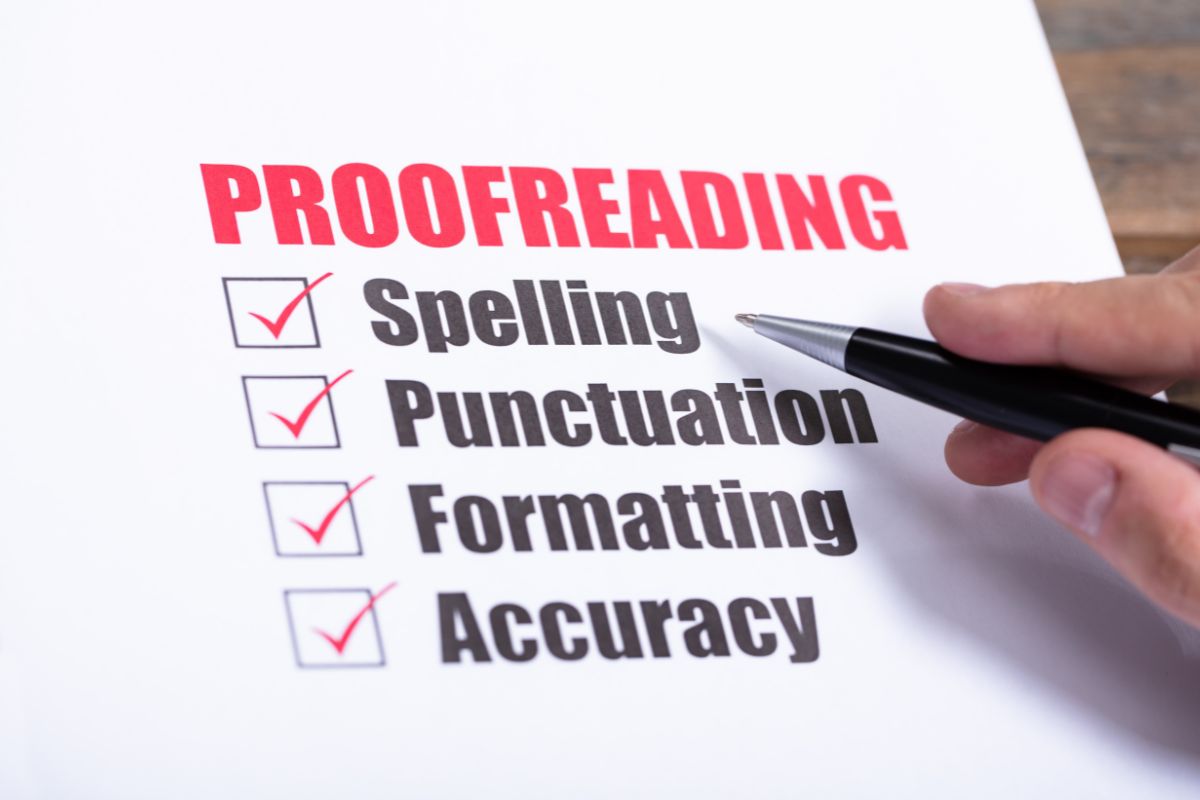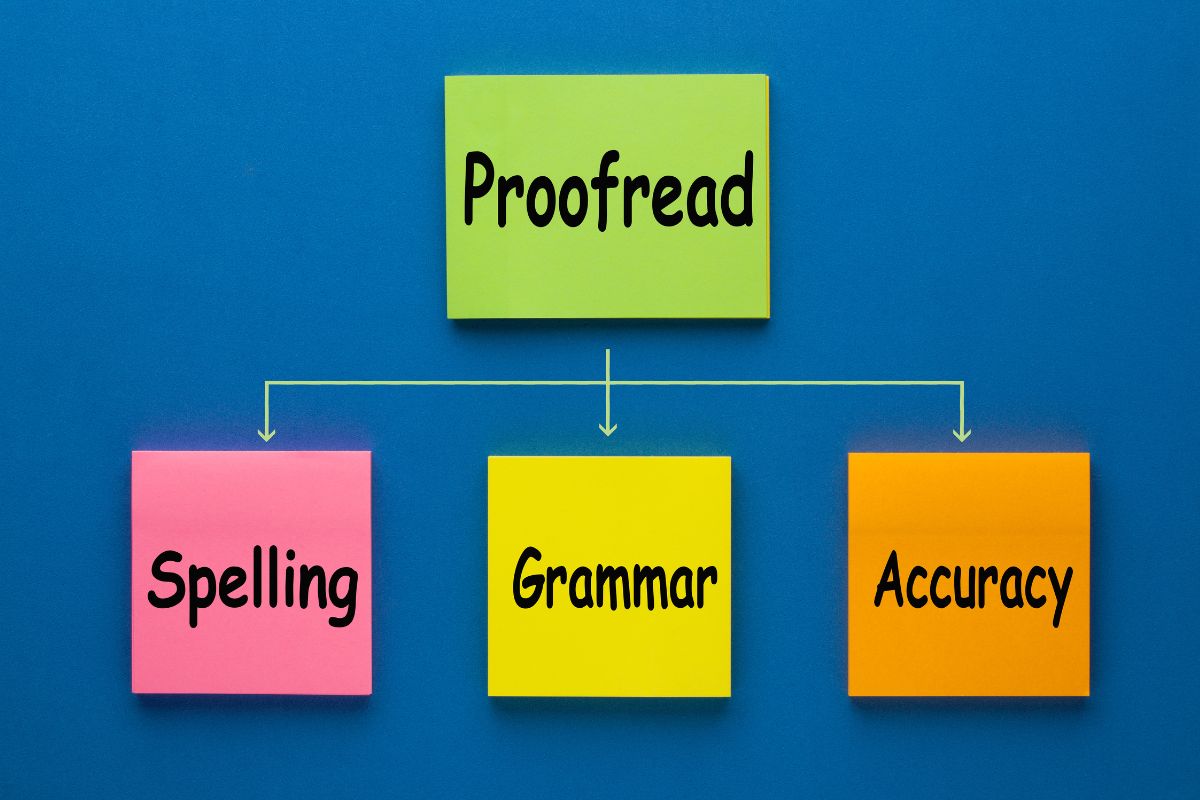The demand for impeccable written content has never been higher.
Whether it’s for a blog post, a novel, or a business report, the need for error-free writing is paramount.
Enter the proofreader: a guardian of grammar, a sentinel of syntax, and a champion of clarity.
But how does one step into this crucial role, especially in a world brimming with advanced tools and technologies?
This guide will walk you through the modern journey of how to become a proofreader, ensuring that you’re not just correcting errors, but also enhancing the quality of every piece you touch.
Post Contents
- 1 How to Become a Proofreader with No Experience
- 1.1 1. Understand the Role
- 1.2 2. Develop a Passion for Reading
- 1.3 3. Master the Basics of Grammar and Style
- 1.4 4. Choose Your Niche
- 1.5 5. Invest in Modern Proofreading Tools
- 1.6 6. Take Online Courses
- 1.7 7. Join a Proofreading Community
- 1.8 8. Start with Freelance Platforms
- 1.9 9. Build a Portfolio
- 1.10 10. Stay Updated with Language Trends
- 1.11 11. Practice Regularly
- 1.12 12. Offer Free Services Initially
- 1.13 13. Understand the Business Side
- 1.14 14. Set Up a Dedicated Workspace
- 1.15 15. Develop a Proofreading Process
- 1.16 16. Seek Feedback
- 1.17 17. Join Professional Organizations
- 1.18 18. Continuously Upgrade Your Skills
- 2 FAQs
- 3 Wrapping Up
How to Become a Proofreader with No Experience

With the influx of online publications, eBooks, and blogs, the demand for polished and error-free content is soaring.
If you have an eye for detail and a passion for perfection, a career in proofreading might be your calling.
1. Understand the Role
Proofreading isn’t just about spotting typos. It’s an art of ensuring that the content is coherent, consistent, and free from errors.
While editors focus on the content’s structure and flow, proofreaders zoom in on the details.
They check for grammatical errors, punctuation mistakes, and formatting inconsistencies.
In the digital age, this also means ensuring that hyperlinks work and that the content looks good on various devices.
Embracing this comprehensive view of your role will set you on the path to success.
2. Develop a Passion for Reading
The best proofreaders are often voracious readers.
By immersing yourself in diverse reading materials, from novels to newspapers, you naturally hone your ability to spot errors.
Reading widely also exposes you to various writing styles, tones, and genres.
This experience is invaluable, as it helps you adapt to different authors’ voices and ensures that their unique style remains intact while you weed out the mistakes.
3. Master the Basics of Grammar and Style
While tools can assist, a proofreader’s best asset is their knowledge.
Dive deep into grammar rules, punctuation guidelines, and different style guides.
Books like “The Elements of Style” by Strunk and White or the “Chicago Manual of Style” are excellent resources.
In the digital age, you can also leverage online platforms like Grammar Girl or the Purdue OWL for quick refreshers.
Remember, while rules are essential, understanding their application in different contexts is crucial.
4. Choose Your Niche
The world of content is vast.
From academic papers and business reports to novels and blog posts, each type has its intricacies.
While it’s beneficial to have a broad understanding, specializing can make you stand out.
Perhaps you have a background in medicine and can proofread medical journals, or you’re passionate about fiction and can focus on novels.
By choosing a niche, you not only streamline your learning but also position yourself as an expert in that domain.
5. Invest in Modern Proofreading Tools

The digital age has blessed proofreaders with a plethora of tools designed to make their job easier.
Platforms like Grammarly, Hemingway Editor, and ProWritingAid can scan texts and highlight potential errors.
However, these tools should complement, not replace, your skills.
Use them as a safety net, catching what you might have missed on your first pass.
But always trust your judgment over algorithms, as context is something machines still struggle with.
6. Take Online Courses
In our digital era, learning has never been more accessible.
Platforms like Coursera, Udemy, and LinkedIn Learning offer specialized courses on proofreading, grammar, and even the business side of freelancing.
By investing time in these courses, you not only sharpen your skills but also gain a certification that can enhance your credibility.
Plus, these platforms often provide forums where you can engage with instructors and peers, fostering a community of continuous learning.
7. Join a Proofreading Community
There’s a vast community of proofreaders and editors online, eager to share their experiences, challenges, and solutions.
Platforms like Reddit, dedicated Facebook groups, or forums like the ProZ community are treasure troves of insights.
Engaging with peers can provide you with different perspectives, tips on handling tricky proofreading scenarios, and even opportunities for collaboration.
Remember, in the world of freelancing, networking is invaluable.
8. Start with Freelance Platforms
While building a personal brand and clientele takes time, platforms like Upwork, Fiverr, and Freelancer offer a great starting point.
These sites allow you to showcase your skills, build a portfolio, and gather client reviews.
Initially, you might need to take on smaller projects or offer competitive rates, but these early gigs are stepping stones.
They help you gain experience, refine your process, and establish a reputation in the proofreading world.
9. Build a Portfolio
A portfolio is a proofreader’s calling card.
It showcases your expertise, the range of projects you’ve handled, and client testimonials.
Start by creating a personal website or leverage platforms like Behance or PortfolioBox.
Include before-and-after samples of your work (with client permission), detailing the changes you made and why.
This not only highlights your skills but also gives potential clients insight into your proofreading approach and style.
10. Stay Updated with Language Trends

Language is dynamic, constantly evolving with society and culture.
New words emerge, slang becomes mainstream, and grammar rules adapt.
As a modern proofreader, it’s essential to stay updated.
Subscribe to linguistic blogs, follow language experts on social media, and even consider joining organizations like the Linguistic Society.
This proactive approach ensures that your proofreading skills remain relevant and in tune with contemporary language shifts.
11. Practice Regularly
The adage “practice makes perfect” holds especially true for proofreading.
The more you engage with different texts, the sharper your skills become.
Start by offering to proofread content for friends, local businesses, or community newsletters.
Not only does this provide invaluable experience, but it also helps you understand the common mistakes writers make, allowing you to anticipate and address them more efficiently in future projects.
12. Offer Free Services Initially
While it might seem counterintuitive, offering your services for free or at a discounted rate can be a strategic move.
It allows you to build a client base, gather testimonials, and create a word-of-mouth referral system.
Approach local businesses, non-profits, or budding authors. In exchange for your services, request a detailed review or a referral.
These initial projects can be instrumental in building your reputation and portfolio.
13. Understand the Business Side
Proofreading isn’t just about correcting errors; if you’re freelancing, it’s also about managing a business.
Dive into the basics of entrepreneurship.
Learn about invoicing, setting competitive yet profitable rates, and managing client relationships.
Platforms like QuickBooks or FreshBooks can help streamline your financial processes.
Additionally, consider joining webinars or workshops focused on freelancing to gain insights into best practices and industry standards.
14. Set Up a Dedicated Workspace
Your environment plays a significant role in your productivity.
Create a dedicated, distraction-free workspace for your proofreading tasks.
This doesn’t necessarily mean investing in a home office; it could be as simple as a quiet corner with a comfortable chair and good lighting.
Equip your space with essential tools like dictionaries, style guides, and ergonomic computer accessories.
A designated workspace not only boosts efficiency but also mentally prepares you for focused work.
15. Develop a Proofreading Process

Having a systematic approach to your tasks ensures consistency and thoroughness.
Start by reading the content to understand its overall flow and message.
Next, delve into the details, checking for grammatical, punctuation, and syntactical errors.
Use digital tools for an initial scan, but always conduct manual checks.
Finally, read the content aloud; this often helps in catching overlooked mistakes.
Documenting and refining your process over time ensures that you maintain a high standard of quality across all projects.
16. Seek Feedback
In any profession, growth is fueled by feedback.
Constructive criticism helps identify areas of improvement, while positive feedback reinforces good practices.
After completing a project, actively seek feedback from clients.
Understand their level of satisfaction, inquire about any challenges they faced, and ask for suggestions.
This open communication not only enhances your skills but also builds trust with clients, fostering long-term relationships.
17. Join Professional Organizations
Being part of a professional organization, such as the Editorial Freelancers Association or the American Society of Journalists and Authors, offers numerous benefits.
These organizations provide resources, training, networking opportunities, and even job listings.
Moreover, they often have strict membership criteria, so being a member can boost your credibility in the industry.
18. Continuously Upgrade Your Skills

The world of writing, publishing, and technology is ever-evolving.
To stay relevant and competitive, it’s crucial to be a lifelong learner.
Attend workshops, webinars, and conferences.
Engage with industry experts, and stay updated with the latest tools and software.
This commitment to continuous learning ensures that you remain at the forefront of the proofreading profession.
FAQs
Is a Formal Degree Required to Become a Proofreader?
While a degree in English or journalism can be beneficial, it’s not mandatory.
Many successful proofreaders have backgrounds in diverse fields.
What’s crucial is a strong command of the language, attention to detail, and a commitment to continuous learning.
How Do I Differentiate Myself in The Competitive Proofreading Market?
Specializing in a niche, continuously upgrading your skills, seeking certifications, and building a robust portfolio are effective ways to stand out.
Additionally, networking and joining professional organizations can provide a competitive edge.
Can I Rely Solely on Digital Proofreading Tools?
While digital tools are invaluable for initial scans and catching common errors, they aren’t infallible.
A manual review is essential to ensure context, tone, and nuances are preserved.
Using a combination of tools and manual checks ensures the highest quality.
Wrapping Up
Embarking on the path to learning how to become a proofreader is a journey of continuous learning, adaptation, and passion for perfection.
In a world inundated with content, the role of a proofreader is more critical than ever.
By blending traditional skills with contemporary tools and techniques, you can ensure that every piece of content you touch resonates with clarity, coherence, and precision.






























